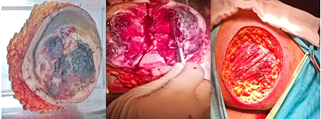Case Report
Rhabdomyosarcoma of the Buttock, Rare Location
- Sawssen Ben Marzouk 1
- Wael Ferjaoui 1*
- Adel Jelassi 1
- Nizar Cherni 2
- Mohamed Hedi Mannai 1
- Mohamed Bechir Khalifa 1
1Department of General surgery, Military University Hospital, Faculty of medicine of Tunis, University of Tunis El Manar, Tunisia.
2Department of Urology, Military University Hospital, Faculty of medicine of Tunis, University of Tunis El Manar, Tunisia.
*Corresponding Author: Wael Ferjaoui, Department of General surgery, Military University Hospital, Faculty of medicine of Tunis, University of Tunis El Manar, Tunisia.
Citation: Sawssen B. Marzouk, Ferjaoui W., Adel Jelassi A., Cherni N., Mohamed H. Mannai, et al. (2023). Rhabdomyosarcoma of the Buttock, Rare Location. Clinical Case Reports and Studies, BioRes Scientia Publishers. 3(3):1-2. DOI: 10.59657/2837-2565.brs.23.070
Copyright: © 2023 Wael Ferjaoui, this is an open-access article distributed under the terms of the Creative Commons Attribution License, which permits unrestricted use, distribution, and reproduction in any medium, provided the original author and source are credited.
Received: September 21, 2023 | Accepted: October 05, 2023 | Published: October 12, 2023
Abstract
Rhabdomyosarcoma is a common mesenchymal tumor in children. it is a rare tumor in adults and exceptional in the elderly. The most frequent locations of rhabdomyosarcomas are the head, neck, orbit and urinary tract, these locations are considered favorable. Other locations are considered unfavorable. We report the case of cutaneous rhabdomyosarcoma of the buttock in a 61-year-old man operated on at our service.
Keywords: rhabdomyosarcoma; buttock; mesenchymal tumor; children
Introduction
Rhabdomyosarcoma is a common mesenchymal tumor in children. it is a rare tumor in adults and exceptional in the elderly. The most frequent locations of rhabdomyosarcomas are the head, neck, orbit and urinary tract, these locations are considered favorable. Other locations are considered unfavorable. We report the case of cutaneous rhabdomyosarcoma of the buttock in a 61-year-old man operated on at our service.
Case Report
A 61-year-old man, with no particular history, 20PA smoker, presented for consultation with a mass in the right buttock, which had been present for 2 years without any notion of trauma, with discomfort and pain when sitting. Initially small in size, it gradually increased in size over these two years with unquantified weight loss. On examination: a budding, firm mass on the right buttock, 10 cm in diameter, ulcerated with a necrotic center, inflamed skin opposite, no blood or pus coming out. The remote extension assessment is negative. The patient underwent a one-piece resection of the tumor mass, passing 1 cm around the mass and respecting the non-invaded muscle plane (figure.1). The pathological examination concluded that it was a rhabdomyosarcoma with very significant inflammatory changes, the resection limits were healthy.
Figure 1: one-piece resection of the tumor mass
Discussion
Rhabdomyosarcoma develops from skeletal striated muscle tissue, it has a poor prognosis due to its rapid progression [1], its metastatic potential and frequent recurrences. This tumor is rare in adults and the elderly [2]. The common locations are respectively the extremities, the head region, the neck and the genitourinary tract; other locations can be seen such as the trunk and the abdomen. The buttock location is exceptional [3]. The rarity of these tumors as well as the multiple locations makes the diagnosis difficult. These tumors are classified into embryonal, alveolar and pleomorphic. Computed tomography and magnetic resonance imaging are used to confirm the location, size and invasion of neighboring organs of the tumor. A thoracoabdominopelvic CT scan is useful for assessing distant extension. The treatment of rhabdomyosarcoma is surgical removal of the tumor and chemotherapy or a combination of the two. Complete resection is achieved by resection of the tumor with 0.5 cm of normal tissue around it. Chemotherapy is indicated to reduce tumor size and to eradicate metastatic foci. There chemotherapy currently used and having proven its effectiveness is based on carboplatin, irinotecan, topotecan and vinorelbine [4]. rhabdomyosarcomas are radiosensitive and the dose used is 50.4 for embryonal and alveolar types [5]. There is no optimal treatment regimen for the management of rhabdomyosarcoma in adults and children.
Conclusion
Rhabdomyosarcoma remains a tumor with a poor prognosis given that the diagnosis is generally made at an advanced stage. The management is multidisciplinary, consisting of surgical resection on which the subsequent prognosis depends and preoperative radio-chemotherapy for the tumors. not immediately resectable.
References
- Chen J, Liu X, Lan J, Li T, She C, Zhang Q, et al. (2022). Rhabdomyosarcoma in Adults: Case Series and Literature Review. Int J Womens Health. 14:405-414.
Publisher | Google Scholor - Desai KB, Mella D, Pan E. (2019). An Adult Patient with Rare Primary Intracranial Alveolar Rhabdomyosarcoma. Anticancer Res. Juin, 2019;39(6):3067-3070.
Publisher | Google Scholor - V.E.S KT, S. O, P. H, K. K, E. F, K. T, et al. (2021). Rhabdomyosarcome de I’iliopsoas : Localisation Exceptionnelle Chez une Femme de 65 Ans. Eur Sci J ESJ, 17(14).
Publisher | Google Scholor - Das M. (2020). Intelligence outcomes after proton versus photon therapy. Lancet Oncol. 21(1):e16.
Publisher | Google Scholor - M Julieron, YM Robin, N Penel, D Chevalier. (2013). Julieron: Sarcomes de la tête et du cou - Disponible sur, EMC Oto-rhino-laryngologie.
Publisher | Google Scholor












